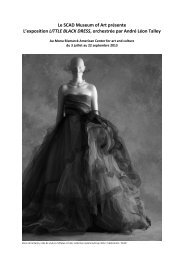Press Release - Mona Bismarck | American Center
Press Release - Mona Bismarck | American Center
Press Release - Mona Bismarck | American Center
Create successful ePaper yourself
Turn your PDF publications into a flip-book with our unique Google optimized e-Paper software.
HISTORY OF A COLLECTION<br />
Mary Cassatt kept all of her prints, related drawings and working proofs – traces of the different<br />
states of her printmaking process. During the realization of a plate, from one change to another,<br />
throughout the successive “bites,” she would make one or several proofs from a plate to appreciate<br />
the result. These intermediary proofs, usually only a few in number, were then much more rare than<br />
the final prints. Indeed, they were the artist’s sketches and comprise part of her creative process.<br />
Mary Cassatt had gathered quite a vast body of prints when she decided to sell them to Ambroise<br />
Vollard. Every step of her career was represented, from her first etchings of 1870 to her 1890s color<br />
sets. Overall, the studio collection consisted of approximately 300 prints, drawings and<br />
counterproofs, most of which would probably be missing today if Vollard had not kept them so<br />
carefully.<br />
More than twenty years separated Mary Cassatt and Ambroise Vollard (1866-1939). Born in 1866 in<br />
La Réunion, Vollard left his native island for metropolitan France where he studied law and cultivated<br />
his passion for art, which led him to open his own gallery in 1893.<br />
He met Mary Cassatt in the 1890s when she was still under contract with Durand-Ruel. The art dealer<br />
was immediately struck by the modernity and vitality of her work on paper, and by the impressions<br />
of the many different states of her prints. Passionate for the graphic arts, Vollard worked hard to<br />
convince the greatest artists of his time to pursue printmaking as a major activity.<br />
His first significant deal with Cassatt dates to 1906 when Vollard went to the artist's country house in<br />
Mesnil-Théribus, Oise. At this time, he was also working with very avant-garde artists: for instance<br />
the first Pablo Picasso exhibition in Paris took place at his gallery, when Picasso was only 19.<br />
Later in his career, Vollard purchased Mary Cassatt's collection of prints and drawings, most of which<br />
had never been exhibited. These works remained in his possession until his death in 1939. Vollard<br />
was known for buying entire studio collections from a given artist at once, and everything he bought<br />
or published was eventually the subject of a sale. He sold many of the pastels and paintings he had<br />
bought from Cassatt, but he kept her prints – perhaps the joy of owning them surpassed any idea of<br />
profit.<br />
The “studio collection,” from which the works included in this exhibition come, upon Vollard’s death<br />
in 1939, was bought by the art dealer and collector Henri Petiet. Petiet placed a few of Cassatt's<br />
works in the best <strong>American</strong> museums - among them the Museum of Fine Arts, Boston and the<br />
National Gallery of Art in Washington, D.C. - so that the artist would be recognized in her native<br />
country. The rest of the collection remained quite unknown (except to a few lucky connoisseurs).<br />
In 2000, part of this trove was at last revealed to the public by Marc Rosen Fine Art at the Adelson<br />
Galleries in New York. In 2004 another aspect of Mary Cassatt's experimentation was unveiled at the<br />
same place in the exhibition Art in a Mirror: The Counterproofs of Mary Cassatt, which presented her<br />
pastel counterproofs for the first time. In 2008, a third part of the collection was displayed at the<br />
gallery. This exhibition marks the first time the collection is shown in Europe.<br />
10







